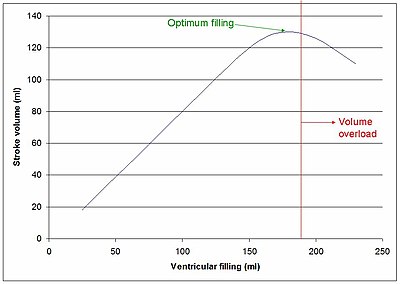
Volume overload refers to the state of one of the chambers of the heart in which too large a volume of blood exists within it for it to function efficiently. Ventricular volume overload is approximately equivalent to an excessively high preload. It is a cause of cardiac failure.
Pathophysiology
In accordance with the Frank–Starling law of the heart, the myocardium contracts more powerfully as the end-diastolic volume increases. Stretching of the myofibrils in cardiac muscle causes them to contract more powerfully due to a greater number of cross-bridges being formed between the myofibrils within cardiac myocytes. This is true up to a point, however beyond this there is a loss of contractile ability due to loss of connection between myofibrils; see figure.
Various pathologies, listed below, can lead to volume overload. Different mechanisms are involved depending on the cause, however the common theme is that of a high cardiac output with a low or normal afterload. The output may be high due to the inefficiency in valve disease, or it may be high due to shunting of blood in left-to-right shunts and arteriovenous malformations.
Left ventricular volume overload may produce inverted u waves on the electrocardiogram.
Causes
Causes may be considered according to which chamber is affected.
Left ventricular volume overload
- Valvular heart disease
- Aortic regurgitation
- Mitral regurgitation, also causing left atrial volume overload
- Congenital heart defects
- Patent ductus arteriosus
- Ventricular septal defect, also causing left atrial volume overload
- Arteriovenous malformation and fistula
- Giant hepatic haemangioma
- High-output haemodialysis fistula
Right ventricular volume overload
- Valvular heart disease
- Congenital heart defects
- Atrial septal defect, also causing right atrial volume overload
See also
References
- Costanzo, Linda S. (2007). Physiology. Hagerstwon, MD: Lippincott Williams & Wilkins. pp. 81. ISBN 978-0-7817-7311-9.
- Klabunde, Richard E. "Cardiovascular Physiology Concepts". Lippincott Williams & Wilkins, 2011, p. 74.
- Conrath C, Opthof T (2005). "The patient U wave". Cardiovasc Res. 67 (2): 184–6. doi:10.1016/j.cardiores.2005.05.027. PMID 15979057.
- Left Ventricular Volume Overload, Discussion of echocardiography findings.
- Gehl LG, Mintz GS, Kotler MN, Segal BL (1982). "Left atrial volume overload in mitral regurgitation: a two dimensional echocardiographic study". Am J Cardiol. 49 (1): 33–8. doi:10.1016/0002-9149(82)90274-0. PMID 7053608.
- ^ Gardiner M, Eisen S, Murphy C. Training in paediatrics: the essential curriculum. Oxford University Press, Oxford 2009.
| Physiology of the cardiovascular system | |||||||||||||
|---|---|---|---|---|---|---|---|---|---|---|---|---|---|
| Heart |
| ||||||||||||
| Vascular system/ hemodynamics |
| ||||||||||||